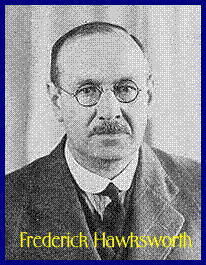Nationality British Role Mechanical Engineer | Name Frederick Hawksworth | |
 | ||
Born 10 February 1884 ( 1884-02-10 ) Swindon Died July 13, 1976, Swindon, United Kingdom | ||
Frederick William Hawksworth (10 February 1884 – 13 July 1976), was the last Chief Mechanical Engineer of the Great Western Railway (Great Britain) (GWR).
Contents
Early career
Hawksworth spent his entire career at the Swindon Works of the GWR. He joined the company as an apprentice in 1898, aged 15, becoming an apprentice draughtsman in 1905 under George Jackson Churchward. Hawksworth was one of Churchward's "Bright Young Men", and was involved in his revolutionary designs including the general arrangement drawings for "The Great Bear".
Following Churchward's retirement in December 1921, Hawksworth was appointed Chief Draughtsman to his successor Charles Collett where he co-ordinated the work on the King Class. In 1932 he was appointed Assistant, to the Chief Mechanical Engineer, following the departure of William Stanier to the London Midland and Scottish Railway. Soon afterwards he became Principal Assistant. However, having been at the forefront of steam locomotive development, ideas at Swindon Works had somewhat stagnated under the later years of Collett, now in his seventies and whose reluctance to give up the CME's post resulted in Hawksworth's lateness in taking up this position.
Hawksworth 'was instrumental in getting the stationary locomotive testing plant at Swindon modernized abd the development of testing practice which took place during the later 1930s was eventually accepted by British Railways as a nation Standard.'
Chief Mechanical Engineer
Hawksworth became CME following Collett's retirement at the age of 70 in 1941. He continued in the design tradition which he had been involved in throughout his career, but also made some important improvements. In particular increased superheat started to be fitted to the larger classes under his regime, and the works started to make much more use of welded construction. Another prominent new concept was a tender with slab sides, using welded construction, giving a much smoother appearance than the traditional design with stepped sides and riveted plates.
Modified Hall Class
His first design to be built, from 1944, was the Modified Hall, a significant development of the Collett design with increased superheat and very different cylinder and frame construction.
County Class
After the war there were four more new designs, mostly improvements of earlier types. The 'County' Class 4-6-0 was the last and most powerful GWR 2-cylinder 4-6-0, the culmination of a line that began with the 'Saints' 42 years before. The chassis was similar to the modified Hall, but the boilers were to a new design, larger in diameter than the Std 1 (Hall) boiler but smaller in diameter and appreciably shorter than the Castle boiler. This boiler used tooling which was available from LMS 8F 2-8-0 boilers which Swindon had built for the Railway Executive during World War II and was pressed to 280psi, higher pressure than any previous GWR boiler. They used some of the names from the vanished Churchward County Class 4-4-0s.
9400 Class
The taper boilered 9400 Class 0-6-0 pannier tank, was built in large numbers by outside contractors. These were similar to the 5700 class under the footplate but had a much larger boiler giving them more power and adhesive weight - and thus braking capacity. Only the first ten, built by the Swindon, appeared under the GWR. The last two designs were only seen in British Railways livery.
1500 Class
Arguably his most radical design was the 1500 Class. This had the same boiler as the 9400 but an all new short wheelbase chassis with outside Walschaerts valve gear and no running plate, and made considerable use of welded construction. They were designed for easy maintenance by the trackside.
1600 Class
The last Hawksworth design was a very light conventional 0-6-0 pannier tank, the 1600 Class. This was a modernisation of the 2021 Class, which was now life expired.
Other designs
Hawksworth was involved in the ordering of the GWR diesel shunters and two experimental Gas turbine-electric locomotives Nos. 18000 and 18100.
British Railways
Hawksworth remained Chief Mechanical Engineer through the formation of the Western Region of British Railways in 1948, continuing to work on locomotive design until retiring at the end of 1949.
Retirement and death
He was chairman of the Swindon magistrates from 1951 until 1959 and was made a freeman of the borough in 1960. He died in Swindon in July 1976. His ashes are buried in St. Mark's Church, adjacent to the former site of Swindon Works.
Preservation
Examples of all the Hawksworth designs except the 'Counties' survive. The Great Western Society is in the process of building a new 'County', a replica of No.1014 County of Glamorgan, using the frames of a 'Modified Hall', parts of the boiler of an LMS Class 8 2-8-0, and an original chimney from No.1006 County of Cornwall.
